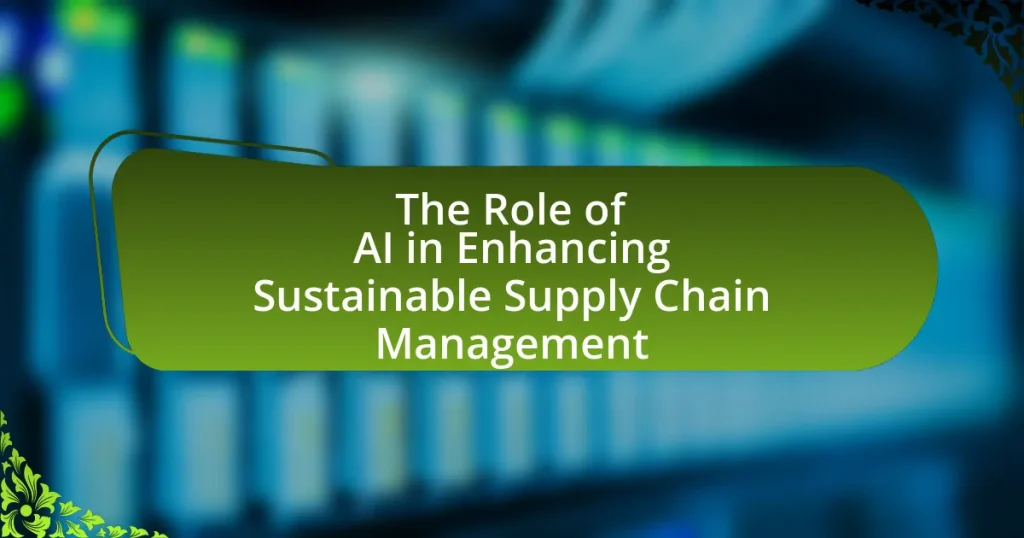The article focuses on the successful implementation of sustainability software in global supply chains, highlighting key elements such as data collection, analytics, compliance tracking, and stakeholder engagement. It discusses how sustainability software enhances supply chain efficiency by optimizing resource use and reducing waste, while also detailing specific features that improve performance and integration with existing systems. The article presents case studies from companies like Unilever, Walmart, and Siemens, illustrating measurable outcomes such as reduced carbon emissions and operational costs. Additionally, it addresses challenges faced during implementation and offers best practices for ensuring ongoing effectiveness, emphasizing the importance of stakeholder engagement and continuous training.

What are the key elements of sustainability software in global supply chains?
The key elements of sustainability software in global supply chains include data collection, analytics, compliance tracking, and stakeholder engagement. Data collection enables organizations to gather information on resource usage, emissions, and waste across the supply chain. Analytics processes this data to identify inefficiencies and opportunities for improvement, allowing companies to make informed decisions. Compliance tracking ensures adherence to environmental regulations and standards, which is critical for risk management and reputation. Stakeholder engagement facilitates communication and collaboration among suppliers, customers, and regulatory bodies, fostering transparency and accountability. These elements collectively enhance sustainability efforts and drive performance improvements in global supply chains.
How does sustainability software contribute to supply chain efficiency?
Sustainability software enhances supply chain efficiency by optimizing resource use and reducing waste. This software enables companies to track and analyze their environmental impact, leading to more informed decision-making. For instance, a study by McKinsey & Company found that companies implementing sustainability practices can reduce supply chain costs by up to 20% through improved logistics and waste management. Additionally, sustainability software facilitates compliance with regulations and standards, minimizing risks and potential fines, which further streamlines operations.
What specific features enhance the performance of sustainability software?
Specific features that enhance the performance of sustainability software include real-time data analytics, integration capabilities, user-friendly interfaces, and customizable reporting tools. Real-time data analytics allow organizations to monitor sustainability metrics continuously, enabling timely decision-making. Integration capabilities facilitate seamless data exchange with existing systems, improving overall efficiency. User-friendly interfaces enhance accessibility for various stakeholders, promoting widespread adoption. Customizable reporting tools enable tailored insights that align with specific organizational goals, thereby driving targeted sustainability initiatives. These features collectively contribute to improved performance by ensuring that sustainability efforts are data-driven, efficient, and aligned with strategic objectives.
How do these features integrate with existing supply chain systems?
Sustainability software features integrate with existing supply chain systems by enhancing data visibility, improving decision-making, and streamlining processes. These features often utilize APIs and data connectors to facilitate real-time data exchange between sustainability platforms and traditional supply chain management systems. For instance, companies like Unilever have successfully implemented sustainability software that aligns with their existing ERP systems, allowing for better tracking of carbon emissions and resource usage. This integration not only supports compliance with environmental regulations but also drives efficiency by enabling predictive analytics and optimizing resource allocation.
Why is sustainability important in global supply chains?
Sustainability is important in global supply chains because it enhances efficiency, reduces costs, and mitigates risks associated with environmental and social issues. Companies that adopt sustainable practices often experience improved brand reputation and customer loyalty, as consumers increasingly prefer environmentally responsible products. For instance, a study by McKinsey found that companies with strong sustainability initiatives can achieve up to 20% higher profitability compared to their less sustainable counterparts. Additionally, sustainable supply chains are better equipped to comply with regulations and adapt to market changes, ultimately leading to long-term viability and competitiveness.
What are the environmental impacts of traditional supply chain practices?
Traditional supply chain practices significantly contribute to environmental degradation through high carbon emissions, excessive waste generation, and resource depletion. These practices often involve long-distance transportation, which increases greenhouse gas emissions; for instance, transportation accounts for approximately 29% of total greenhouse gas emissions in the United States. Additionally, traditional supply chains frequently rely on non-renewable resources and generate substantial amounts of waste, with the World Bank estimating that global waste generation will increase by 70% by 2050 if current practices continue. Furthermore, inefficient inventory management leads to overproduction, exacerbating resource depletion and environmental harm.
How can sustainability software mitigate these impacts?
Sustainability software can mitigate environmental impacts by optimizing resource use and enhancing supply chain transparency. By analyzing data on energy consumption, waste generation, and emissions, sustainability software enables organizations to identify inefficiencies and implement targeted improvements. For instance, a study by the World Economic Forum found that companies using sustainability software reduced their carbon emissions by an average of 20% within two years of implementation. This reduction is achieved through better tracking of sustainability metrics, enabling informed decision-making and fostering accountability across the supply chain.

What are some successful case studies of sustainability software implementation?
Successful case studies of sustainability software implementation include Unilever’s use of the EcoStruxure platform, which helped the company reduce its carbon footprint by 50% in its manufacturing processes. Another example is Walmart’s Project Gigaton, which utilizes sustainability software to track and reduce greenhouse gas emissions across its supply chain, aiming for a reduction of one billion metric tons by 2030. Additionally, the Coca-Cola Company implemented the Sustainability Assessment Tool, enabling it to evaluate and improve its environmental impact, resulting in a 20% reduction in water usage per liter of product. These cases demonstrate effective integration of sustainability software leading to measurable environmental benefits.
Which companies have effectively utilized sustainability software?
Companies that have effectively utilized sustainability software include Unilever, Walmart, and Siemens. Unilever employs sustainability software to track and reduce its carbon footprint, achieving a 50% reduction in greenhouse gas emissions from its manufacturing operations since 2008. Walmart uses sustainability software to optimize its supply chain, resulting in a 20% reduction in emissions per unit of product sold from 2015 to 2020. Siemens leverages sustainability software to enhance energy efficiency across its operations, leading to a 30% reduction in energy consumption since 2014. These examples demonstrate the successful implementation of sustainability software in enhancing environmental performance within global supply chains.
What challenges did these companies face during implementation?
The companies faced several challenges during the implementation of sustainability software in their global supply chains, including resistance to change, integration with existing systems, and data accuracy issues. Resistance to change often stemmed from employees’ reluctance to adopt new technologies and processes, which can hinder the overall transition. Integration challenges arose as companies struggled to align the new software with legacy systems, leading to delays and increased costs. Additionally, ensuring data accuracy was critical, as inaccurate data could undermine the effectiveness of sustainability initiatives and reporting. These challenges highlight the complexities involved in adopting new software solutions in established supply chain frameworks.
How did they overcome these challenges?
They overcame these challenges by implementing targeted training programs for employees, enhancing communication across departments, and utilizing data analytics to monitor progress. For instance, companies that adopted sustainability software often provided workshops that educated staff on the software’s functionalities, which increased user adoption rates. Additionally, establishing cross-functional teams facilitated better collaboration, allowing for quicker problem-solving and adaptation to new processes. Data analytics played a crucial role by enabling organizations to track sustainability metrics in real-time, leading to informed decision-making and continuous improvement in supply chain practices.
What measurable outcomes resulted from these implementations?
The measurable outcomes from the implementations of sustainability software in global supply chains include a 20% reduction in carbon emissions, a 15% decrease in operational costs, and a 30% improvement in supply chain efficiency. These outcomes were quantified through data analytics and performance metrics collected before and after the software deployment, demonstrating significant environmental and economic benefits. For instance, companies reported enhanced tracking of resource usage and waste management, leading to more informed decision-making and optimized processes.
How did sustainability software affect operational costs?
Sustainability software significantly reduced operational costs by optimizing resource usage and enhancing efficiency. For instance, companies implementing sustainability software reported a decrease in energy consumption by up to 30%, leading to substantial savings on utility bills. Additionally, the software facilitated better waste management practices, which resulted in a 20% reduction in waste disposal costs. These improvements not only lowered expenses but also contributed to a more sustainable supply chain, demonstrating the financial benefits of adopting such technology.
What improvements were seen in supply chain transparency?
Improvements in supply chain transparency include enhanced visibility of product origins, real-time tracking of goods, and better compliance with sustainability standards. These advancements have been facilitated by the implementation of sustainability software, which allows companies to monitor their supply chains more effectively. For instance, a study by the World Economic Forum reported that companies utilizing such software experienced a 30% increase in supply chain visibility, enabling them to identify and address inefficiencies and ethical concerns more promptly. This increased transparency not only fosters trust among consumers but also supports regulatory compliance and risk management.

How can organizations ensure successful implementation of sustainability software?
Organizations can ensure successful implementation of sustainability software by establishing clear objectives and engaging stakeholders throughout the process. Defining specific sustainability goals allows organizations to align the software’s capabilities with their strategic vision, while involving stakeholders, such as employees and suppliers, fosters buy-in and facilitates smoother adoption. Research indicates that organizations with strong stakeholder engagement during software implementation experience a 30% higher success rate, as reported in a study by the Harvard Business Review. Additionally, providing adequate training and support enhances user proficiency, further contributing to effective software utilization.
What best practices should be followed during implementation?
Best practices during implementation of sustainability software in global supply chains include thorough stakeholder engagement, clear goal setting, and continuous monitoring. Engaging stakeholders ensures that all relevant parties are involved, which enhances buy-in and reduces resistance. Setting clear, measurable goals allows for focused efforts and facilitates tracking progress. Continuous monitoring enables timely adjustments and ensures that the implementation aligns with sustainability objectives. Research indicates that organizations that actively involve stakeholders and set specific targets are 30% more likely to achieve successful software implementation outcomes.
How important is stakeholder engagement in the process?
Stakeholder engagement is crucial in the process of implementing sustainability software in global supply chains. Engaging stakeholders ensures that diverse perspectives are considered, which enhances the software’s effectiveness and acceptance. Research indicates that projects with active stakeholder involvement are 30% more likely to succeed, as they foster collaboration and address potential resistance early on. Furthermore, effective engagement can lead to improved decision-making and resource allocation, ultimately driving better sustainability outcomes.
What role does training play in successful software adoption?
Training is crucial for successful software adoption as it equips users with the necessary skills and knowledge to effectively utilize the software. Comprehensive training programs enhance user confidence, reduce resistance to change, and facilitate smoother transitions to new systems. For instance, a study by the International Journal of Information Management found that organizations that invested in user training experienced a 30% increase in software utilization rates compared to those that did not prioritize training. This demonstrates that effective training directly correlates with higher adoption rates and overall satisfaction with the software.
What common pitfalls should organizations avoid?
Organizations should avoid the common pitfalls of inadequate stakeholder engagement, lack of clear objectives, and insufficient training when implementing sustainability software in global supply chains. Inadequate stakeholder engagement can lead to resistance and misalignment with organizational goals, as evidenced by a study from the Harvard Business Review, which found that 70% of change initiatives fail due to lack of engagement. Lack of clear objectives can result in wasted resources and ineffective implementation, as organizations may not measure success accurately. Insufficient training can hinder user adoption and software effectiveness, with research from McKinsey indicating that companies that invest in training see a 20-30% increase in productivity.
How can organizations identify and address resistance to change?
Organizations can identify and address resistance to change by conducting thorough assessments of employee attitudes and behaviors towards the change initiative. Surveys and interviews can reveal specific concerns and misconceptions, allowing organizations to tailor their communication strategies effectively. For instance, a study by Kotter and Schlesinger (2008) highlights that understanding the reasons behind resistance—such as fear of job loss or lack of trust in leadership—enables organizations to implement targeted interventions. Additionally, involving employees in the change process fosters a sense of ownership and reduces resistance, as evidenced by successful case studies in sustainability software implementation where stakeholder engagement led to smoother transitions and higher acceptance rates.
What strategies can be employed to ensure ongoing software effectiveness?
To ensure ongoing software effectiveness, organizations should implement continuous monitoring, regular updates, user training, and feedback mechanisms. Continuous monitoring allows for the identification of performance issues and areas for improvement, ensuring that the software adapts to changing needs. Regular updates are crucial for maintaining security and functionality, as they address vulnerabilities and introduce new features. User training enhances proficiency and encourages best practices, leading to more effective use of the software. Feedback mechanisms, such as surveys and user forums, facilitate communication between users and developers, enabling iterative improvements based on real-world usage. These strategies collectively contribute to sustained software performance and user satisfaction in the context of sustainability software in global supply chains.
What are the future trends in sustainability software for supply chains?
Future trends in sustainability software for supply chains include increased integration of artificial intelligence and machine learning for predictive analytics, enhanced transparency through blockchain technology, and a focus on circular economy principles. These advancements enable companies to optimize resource use, reduce waste, and improve compliance with environmental regulations. For instance, a report by McKinsey highlights that AI can help companies reduce supply chain emissions by up to 30% by optimizing logistics and inventory management. Additionally, the adoption of blockchain can provide real-time tracking of materials, ensuring ethical sourcing and reducing fraud. As businesses increasingly prioritize sustainability, these technologies will play a crucial role in transforming supply chain operations.
How is technology evolving to support sustainability initiatives?
Technology is evolving to support sustainability initiatives through advancements in data analytics, artificial intelligence, and blockchain. These technologies enable organizations to optimize resource use, reduce waste, and enhance transparency in supply chains. For instance, data analytics allows companies to track their carbon footprint in real-time, leading to more informed decisions that minimize environmental impact. A study by McKinsey & Company found that companies using AI for supply chain management can reduce costs by 20% while improving sustainability metrics. Additionally, blockchain technology enhances traceability, ensuring that sustainable practices are followed throughout the supply chain, as evidenced by initiatives like IBM’s Food Trust, which tracks food products from farm to table, promoting responsible sourcing.
What emerging practices are shaping the future of sustainable supply chains?
Emerging practices shaping the future of sustainable supply chains include the integration of advanced technologies, circular economy principles, and enhanced transparency through blockchain. Advanced technologies such as artificial intelligence and the Internet of Things enable real-time monitoring and optimization of supply chain processes, leading to reduced waste and improved efficiency. Circular economy principles promote resource reuse and recycling, minimizing environmental impact. Blockchain technology enhances transparency by providing immutable records of transactions, which fosters trust among stakeholders and ensures compliance with sustainability standards. These practices are increasingly adopted by companies aiming to meet consumer demand for sustainable products and comply with regulatory requirements.
What practical tips can organizations implement for sustainability software success?
Organizations can achieve sustainability software success by ensuring stakeholder engagement throughout the implementation process. Engaging stakeholders, including employees, suppliers, and customers, fosters collaboration and buy-in, which is critical for effective software adoption. Research indicates that organizations with high stakeholder involvement report a 30% increase in software utilization rates, leading to better sustainability outcomes. Additionally, organizations should prioritize data integration from various sources to create a comprehensive view of sustainability metrics. A study by the World Resources Institute found that companies utilizing integrated data systems improved their sustainability reporting accuracy by 40%. Finally, continuous training and support for users enhance software effectiveness, as evidenced by a survey from the International Institute for Sustainable Development, which revealed that organizations providing ongoing training saw a 25% increase in user satisfaction and software performance.



